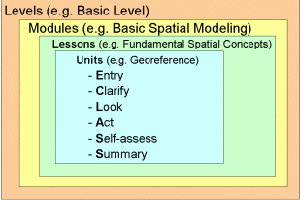ECLASS - The pedagogical concept behind eLML
 The ECLASS model used on unit level in eLML
Diverse efforts have focused on research into finding an adequate didactic structure. Currently eLMLeLML is based on the ECLASSECLASS structure (Gerson 2000). We adapted the model according to our needs as described below:
The ECLASS model used on unit level in eLML
Diverse efforts have focused on research into finding an adequate didactic structure. Currently eLMLeLML is based on the ECLASSECLASS structure (Gerson 2000). We adapted the model according to our needs as described below:
- Entry refers to the introductory statements made before each single lecture unit in a class. An example for an entry could be: What is to be discussed? Why is this topic being introduced? Originally the first E stood for "explain" which is also what the introduction does.
- Clarify represents the core of what is being taught in a unit and its key concepts. In this section, the reading of facts is inevitable. Module related concepts are conveyed. In our case, Data Presentation, a short example is shown to help students visualize the problem.
- Look allows students to review examples or samples of a model that will be taught. It defines the important aspects of the unit through illustrations, animations, videos, white board activities etc.
- Act is to encourage the student to practice what he or she has just been taught. It should be an important integral part of the online learning course, as it actively engages the student.
- Summary is a new point added to M. Gersons structure. It should sum up a unit and point out the main facts shown in this unit. It should contain what was learned and possibly also further expectations. In (2000) the second S stood for share, meaning group exercises. In the self-developed learning structure eLML, we introduced the Summary as second S and used only one exercise object, the self-assessment.